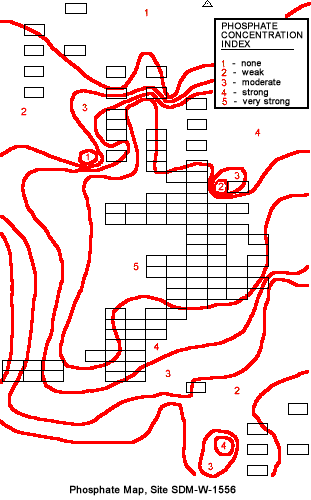Soil Phosphate
In several regions, archaeological deposits have been found to be artificially enriched in phosphates, particularly as a result of the deposition and decomposition of human wastes and animal bone. The uses of soil phosphate studies in archaeology was reviewed by Philip Bethell and Ian Máté (1989). Robert C. Eidt (1973) developed a rapid, inexpensive field test for relative soil phosphate concentrations that has been used to identify and interpret anthropogenic soils. Suggested uses of Eidt’s technique have included the discovery of site boundaries, activity areas, features, and discontinuities in cultural deposition. Potential problems in its use include leaching of phosphates under certain soil pH conditions, naturally high background phosphate concentrations in some soils, possible phosphate enrichment as a result of modern cultural activities, and ambiguities in interpreting the causes of prehistoric phosphate enrichment.
The Eidt soil phosphate technique has been applied in several archaeological studies in San Diego County:
- At site SDM-W-240, the San Dieguito discovery site in Escondido, testing during Palomar College excavations did not identify any phosphate concentrations associated with the site deposit (Laylander 1977).

- At site SDM-W-1556, a Late Prehistoric/Archaic habitation site in San Marcos, the main midden area was fairly well defined by high relative phosphate values (“4” and “5” on Eidt’s scale) as against low values (“1” and “2”) on the midden’s periphery (O’Neil 1982:185-187).
- At site SDI-4845 in Carlsbad, moderate phosphate values identified the areas of highest intensity in use at six loci (Cerreto 1986).
- At site SDM-W-223A, a Late Prehistoric settlement north of Escondido, the pattern of phosphate values was somewhat irregular, but it included strong values (“4” and “5”) in the central area and weak values (“1” and “2”) toward the periphery (Quintero 1987).
- At site SDI-5938, a Late Prehistoric habitation site near Rancho Bernardo, the majority of the site area showed no phosphate enrichment, but some portions had relative values of “2” to “4.” Some of the areas of enrichment were associated with cultural features (Cerreto 1987).
- At site SDI-48, an Archaic-period site on Point Loma, both a horizontal grid and vertical samples from the sidewalls of excavation units were tested. With only minor exceptions, moderate to high phosphate values (“3” and “4”) prevailed throughout two activity loci and throughout the vertical profiles (Gallegos and Kyle 1988).
- At SDI-10,246, an Archaic-period site near Jamul, phosphate values were generally low (“1”), with some higher values (“2” and “3”) in the central site area (Cerreto 1989).
PROSPECTS
Future archaeological investigations may be able to evaluate the usefulness of phosphate testing for such objectives as site boundary definition, the detection of buried features, stratigraphic characterization, and the identification of site functions.